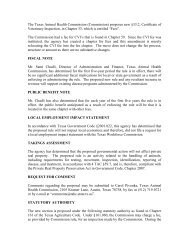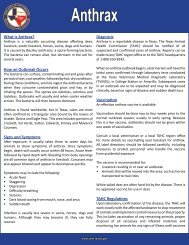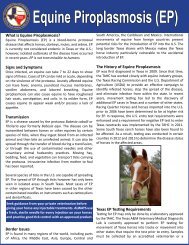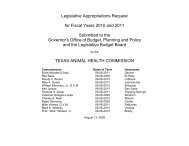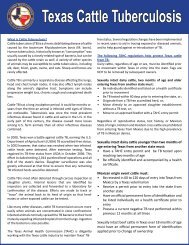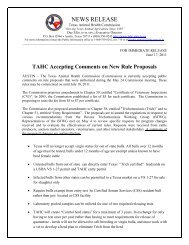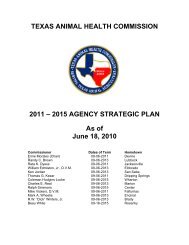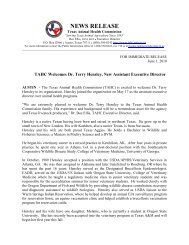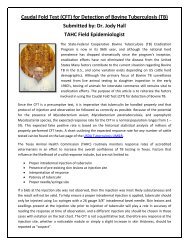EIA Brochure - Texas Animal Health Commission
EIA Brochure - Texas Animal Health Commission
EIA Brochure - Texas Animal Health Commission
Create successful ePaper yourself
Turn your PDF publications into a flip-book with our unique Google optimized e-Paper software.
TEXAS ANIMAL HEALTH COMMISSION• •EquineSince1893SERVING TEXAS ANIMAL AGRICULTUREInfectious Anemia (<strong>EIA</strong>)What is Equine Infectious Anemia (<strong>EIA</strong>)?Equine infectious anemia (<strong>EIA</strong>) is an incurable, infectious diseasecaused by a virus that can affect horses, donkeys, asses and otherequine. This virus destroys red blood cells and is spread throughblood-to-blood contact, not through close proximity or casualcontact. The virus can be transmitted from an infected equine to a“clean” equine by biting flies, the use of unsterilized or contaminatedmedical instruments, or through a blood transfusion. This diseasedoes not affect humans.Depending on the equine animal’s disease resistance, the virus’ability to cause disease and stress factors, <strong>EIA</strong> can appear in one ofthree forms:• Acute• Chronic• InapparentThis <strong>Texas</strong> law requires that ALL equine animals, except zebras, eightmonths of age or older have a negative <strong>EIA</strong> test within the previous12 months before undergoing any change-of-ownership with theexemptions listed separately. TAHC regulations DO require zebrasentering <strong>Texas</strong> to have had a negative <strong>EIA</strong> test within the previous 12months and a Certificate of Veterinary Inspection (CVI) also knownas a health certificate, issued within the past 45 days unless theyare moving between approved zoos. All zebras, including those from<strong>Texas</strong>, must have had a negative <strong>EIA</strong> test within the previous 12months, when entering shows, fairs, exhibitions or other assemblies.Failure to comply with the law is a Class “C” misdemeanor. The <strong>Texas</strong><strong>Animal</strong> <strong>Health</strong> <strong>Commission</strong>’s (TAHC) regulations also were amendedto coincide with this law.Exempt from the change-of-ownership testing requirement:• Nursing foals, transferred with their dam, if the dam has testednegative for <strong>EIA</strong> within the previous 12 months• Equine less than eight months oldQ: Can untested equine be tested at a market?A: Yes, but call the market before you haul. The United StatesDepartment of Agriculture (USDA) has specific guidelines for “offsite”<strong>EIA</strong> labs at sale facilities. Some markets may not have anapproved <strong>EIA</strong> laboratory on-site. <strong>EIA</strong> test results may be available inonly a few hours.AcuteAn equine responding acutely may develop fever, go off feed or diesuddenly. Acute responses generally occur seven to 30 days afterinitial exposure to the virus. The animal may test negative for <strong>EIA</strong>for 16 to 42 days because its immune system has not yet produceddetectable antibodies.ChronicChronically infected equine test positive and may develop symptoms,such as weight loss, weakness, anemia and swelling of the lowerlegs, chest and abdomen. Symptoms subside, but may reoccur.InapparentInapparent infected equine show no outward symptoms, but testpositive for the disease. These animals pose the greatest dangerof spreading <strong>EIA</strong> because they show no outward signs of diseasecreating a risk for unsuspecting equine owners.<strong>Texas</strong> LawSince September 1, 1999, the 76th <strong>Texas</strong> Legislature’s House Bill1732 has been in effect. This bill created the <strong>EIA</strong> program in <strong>Texas</strong>If the market does not have a laboratory, an accredited veterinariancan draw a blood sample from the animal and send it to any of <strong>Texas</strong>’many USDA-approved laboratories. Results are generally available inthree to five days.Q: What if my equine tests positive?A: You may opt to have the equine animal retested by requestinga retest in writing. At that time, another blood sample will bedrawn by state/federal personnel only and sent to the State-FederalLaboratory for confirmatory testing.If the positive results were revealed at the livestock market or atanother site away from the premise of origin, you must take yourequine home under quarantine and under a restricted movementpermit, called a USDA form VS 1-27. The VS 1-27 may be issued by anaccredited veterinarian or authorized state and federal personnel.All equine on the premise with the positive animal will be initiallyrestricted.If the confirmatory test is positive, equine shall be identified with a“74-A” freeze or fire-brand on the upper left shoulder or neck within10 days unless the animal is euthanized. (See picture of 74-A brandon the next page)
Infected equine animals may only move otherwise to an approveddiagnostic or research facility, or be returned to the premise oforigin.Q: What about an <strong>EIA</strong> quarantine? What’s needed for quarantinerelease?A: All equine animals that shared the premise with, or wereotherwise exposed to the <strong>EIA</strong>-infected equine, will be placed underquarantine and must be tested for <strong>EIA</strong>. TAHC personnel may drawthe blood sample and send it to the State-Federal Laboratory at nocharge, or an accredited veterinarian may draw the sample at theowner’s expense.TAHC personnel will conduct an epidemiological investigationto determine the equine’s movement history, when they havecommingled with other equine animals, insect control measures,and other information relating to the spread of the disease.Quarantine release depends on two factors:1. The last infected equine on the premise must be moved from thesite under a TAHC-issued VS 1-27 permit to one of the restricteddestinations previously discussed, or euthanized by the owner’sveterinarian.2. At least 60 days after last exposure to the infected animal(s), theequine remaining on the premise must be retested. If all testsare negative, the TAHC will release the quarantine.Q: Can I keep my equine if it tested positive for <strong>EIA</strong>?A: Because an infected equine is considered to be the only reservoirof this disease, it is best to remove the animal from the equinepopulation. If it must be kept, the animal is to be permanentlyquarantined at least 200 yards from other equine. All otherequine on the premise will also remain under quarantine until theinfected animal is isolated or they are tested negative 60 days afterremoval. A quarterly inspection of the quarantined premises will beperformed by the TAHC for as long as the infected equine remainson the premise to ensure the animal has not left or commingled withother equine.Q: What do we need for <strong>Texas</strong> shows, fairs, trail rides, rodeos orany other equine-related assemblies held within the state?A: <strong>Texas</strong> equine participating in <strong>Texas</strong> events must have a negative<strong>EIA</strong> test, performed by a private practitioner, within the past 12months. The <strong>EIA</strong> test document completed by a vet is called a VS10-11 and is official proof of testing. Horse owners should keep thisdocument handy when traveling with the horse.Q: Who is responsible for ensuring that equine animalsparticipating in events have been tested and are accompanied byan <strong>EIA</strong> document?A: The person or group in charge of the event is responsible forensuring that all equine animals are accompanied with a valid VS10-11 <strong>EIA</strong> test document. The person and/or persons responsible forchecking the VS 10-11 test document should look for the test dateand the animal’s description and compare it to the equine animalbeing hauled. Boarding facilities, training stables and pastures mustensure that all equine have a valid negative test.Q: What is an Equine Passport?A: Equine may enter <strong>Texas</strong> and move within the state on an equinepassport or ID card, in lieu of a CVI (health certificate). The passportis valid for 6 months and eliminates the need for a new healthcertificate every 30 to 45 days.The negative test chart (VS 10-11) must be presented with thepassport, when requested. The passport is not valid, however, forentry into <strong>Texas</strong> pari-mutuel race tracks.Information provided by the<strong>Texas</strong> <strong>Animal</strong> <strong>Health</strong> <strong>Commission</strong> (TAHC)P.O. Box 12966-2966Austin, TX 78711Phone: 1-800-550-8242Website: www.tahc.texas.govFacebook: www.facebook.com/<strong>Texas</strong>AHCTwitter: www.twitter.com/TAHCFebruary 2013



